
Maurice Bienvenu Jean Paul Trintignant was a motor racing driver and vintner from France. He competed in the Formula One World Championship for fourteen years, between 1950 and 1964, one of the longest careers in the early years of Formula One. During this time he also competed in sports car racing, including winning the 1954 24 Hours of Le Mans race. Following his retirement from the track Trintignant concentrated on the wine trade.

The Cooper Car Company is a British car manufacturer founded in December 1947 by Charles Cooper and his son John Cooper. Together with John's boyhood friend, Eric Brandon, they began by building racing cars in Charles's small garage in Surbiton, Surrey, England, in 1946. Through the 1950s and early 1960s they reached motor racing's highest levels as their rear-engined, single-seat cars competed in both Formula One and the Indianapolis 500, and their Mini Cooper dominated rally racing. The Cooper name lives on in the Cooper versions of the Mini production cars that are built in England, but is now owned and marketed by BMW.

Christopher Arthur Amon was a New Zealand motor racing driver. He was active in Formula One racing in the 1960s and 1970s and is widely regarded as one of the best F1 drivers never to win a championship Grand Prix. His reputation for bad luck was such that fellow driver Mario Andretti once joked that "if he became an undertaker, people would stop dying". Former Ferrari Technical Director Mauro Forghieri stated that Amon was "by far the best test driver I have ever worked with. He had all the qualities to be a World Champion but bad luck just wouldn't let him be".

The 1955 Monaco Grand Prix was a Formula One motor race held at Monaco on 22 May 1955. It was race 2 of 7 in the 1955 World Championship of Drivers and was given an honorary name, Grand Prix d'Europe. The 100-lap race was won by Ferrari driver Maurice Trintignant after he started from ninth position. Eugenio Castellotti finished second for the Lancia team and Maserati drivers Jean Behra and Cesare Perdisa came in third.
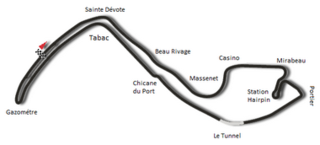
The 1958 Monaco Grand Prix was a Formula One motor race held on 18 May 1958 at Monaco. It was race 2 of 11 in the 1958 World Championship of Drivers and race 2 of 10 in the 1958 International Cup for Formula One Manufacturers. The race was the 16th Monaco Grand Prix and was held over 100 laps of the three kilometre circuit for a total race distance of 314 kilometres.

The 1959 Monaco Grand Prix was a Formula One motor race held at the Circuit de Monaco on 10 May 1959. It was race 1 of 9 in the 1959 World Championship of Drivers and race 1 of 8 in the 1959 International Cup for Formula One Manufacturers. It was also the 17th Monaco Grand Prix. The race was held over 100 laps of the three kilometre circuit for a race distance of 315 kilometres.

The 1960 Formula One season was the 14th season of the FIA's Formula One motor racing. It featured the 11th FIA World Championship of Drivers, the third International Cup for F1 Manufacturers and numerous non-championship Formula One races. The World Championship commenced on 7 February and ended on 20 November after ten races.

The 1959 Formula One season was the 13th season of FIA Formula One motor racing. It featured the 1959 World Championship of Drivers and the 1959 International Cup for F1 Manufacturers, contested concurrently over a nine-race series which commenced on 10 May and ended on 12 December. The season also included a number of non-championship Formula One races.

The 1958 Formula One season was the 12th season of Formula One motor racing. It featured the 1958 World Championship of Drivers which commenced on 19 January 1958, and ended on 19 October after eleven races. This was the first Formula One season in which a manufacturers title was awarded, the International Cup for F1 Manufacturers being contested concurrently with the World Championship of Drivers with the exception of the Indianapolis 500 which did not count towards the Cup. Englishman Mike Hawthorn won the Drivers' title after a close battle with compatriot Stirling Moss and Vanwall won the inaugural Manufacturers award from Ferrari. Hawthorn retired from racing at the end of the season, only to die three months later after a road car accident. It was the first of only two occasions in Formula One history where a driver won the championship having won only one race in the season, the other being Keke Rosberg in 1982.
Team Lotus was the motorsport sister company of English sports car manufacturer Lotus Cars. The team ran cars in many motorsport categories including Formula One, Formula Two, Formula Ford, Formula Junior, IndyCar, and sports car racing. More than ten years after its last race, Team Lotus remained one of the most successful racing teams of all time, winning seven Formula One Constructors' titles, six Drivers' Championships, and the Indianapolis 500 in the United States between 1962 and 1978. Under the direction of founder and chief designer Colin Chapman, Lotus was responsible for many innovative and experimental developments in critical motorsport, in both technical and commercial arenas.
Rob Walker Racing Team was a privateer team in Formula One during the 1950s and 1960s. Founded by Johnnie Walker heir Rob Walker (1917–2002) in 1953, the team became F1's most successful privateer in history, being the first and only entrant to win a World Championship Formula One Grand Prix without ever building their own car.

The Cooper T51 was a Formula One and Formula Two racing car designed by Owen Maddock and built by the Cooper Car Company for the 1959 Formula One season. The T51 earned a significant place in motor racing history when Jack Brabham drove the car to become the first driver to win the World Championship of Drivers with an engine mounted behind them, in 1959. The T51 was raced in several configurations by various entrants until 1963 and in all no less than 38 drivers were entered to drive T51s in Grand Prix races.
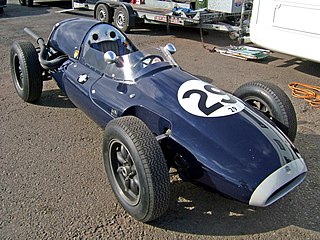
The Cooper T43 was a Formula One and Formula Two racing car designed and built by Cooper Car Company for the 1957 Formula One season, first appearing at the 1957 Monaco Grand Prix in a works car for Jack Brabham. The T43 earned a significant place in motor racing history when Stirling Moss drove a Rob Walker Racing Team T43 to win the 1958 Argentine Grand Prix, the first World Drivers' Championship win for a mid-engined car. Despite this achievement, the car was superseded almost immediately by the T45. The T43's last appearance in a World Championship event was the 1960 Italian Grand Prix.
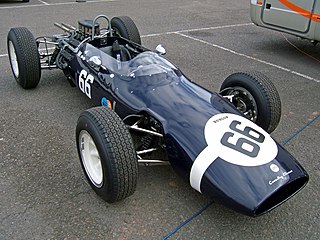
The Cooper T66 is a Formula One racing car from the Cooper Car Company, which was in use from 1963 to 1964.
The 1960 Formula Two season was the last season of 1.5 litre Formula Two racing which was to become Formula One for 1961. Two championships were held over the same five events, the Formula Two Constructors' Championship and the Formula Two Drivers' Championship, in addition to many non-championship Formula Two events. The Constructors' Championship was won in a draw by Cooper-Climax and Porsche, while the Drivers' Championship was won by Jack Brabham.
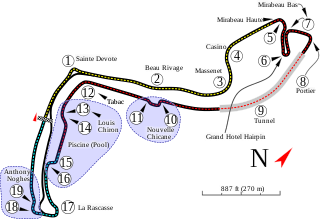
The 2000 Historic Grand Prix of Monaco was the second running of the Historic Grand Prix of Monaco, a motor racing event for heritage Grand Prix, Voiturettes, Formula One, Formula Two and Sports cars.

The Cooper-Bristol, formally called the Cooper Mk.I or the Cooper T20, is a Formula 2 racing car, built, designed, and developed by British manufacturer Cooper Cars in 1952.

The Cooper T23, formally called the Cooper Mk.II, is a Formula 2 racing car, built, designed, and developed by British manufacturer Cooper Cars in 1953. It also competed in Formula One, in 9 Grand Prix between 1953 and 1956. It was powered mainly powered by the 2-liter engine from Bristol, a six-cylinder, but also used a 2-liter Alta L-4 engine, which was used by Stirling Moss.

The Cooper T60 is a Formula One racing car from the Cooper Car Company, which was in use from 1962 to 1965. It won a single World Championship Grand Prix, the 1962 Monaco Grand Prix, driven by Bruce McLaren.
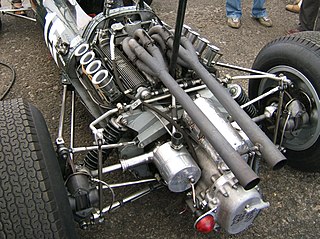
The British Racing Motors V8 was a four-stroke, naturally aspirated, 1.5 L (92 cu in), V-8 racing engine, designed, developed and built by British Racing Motors (BRM) to compete in Formula One racing (although an enlarged 2.0 L version was used for sports car racing. It was built between 1962 and 1967, and came in two version; the P56, and the P60.















